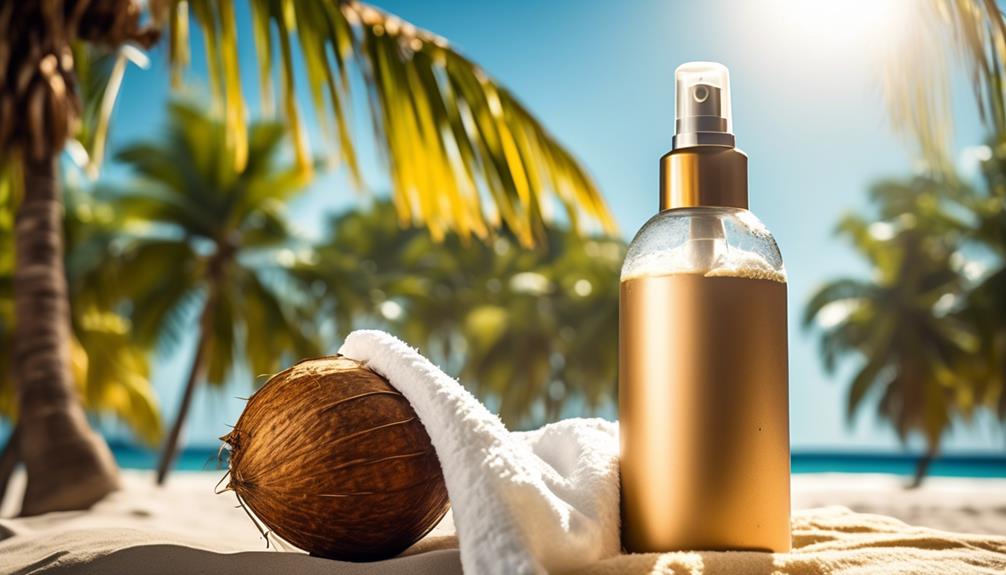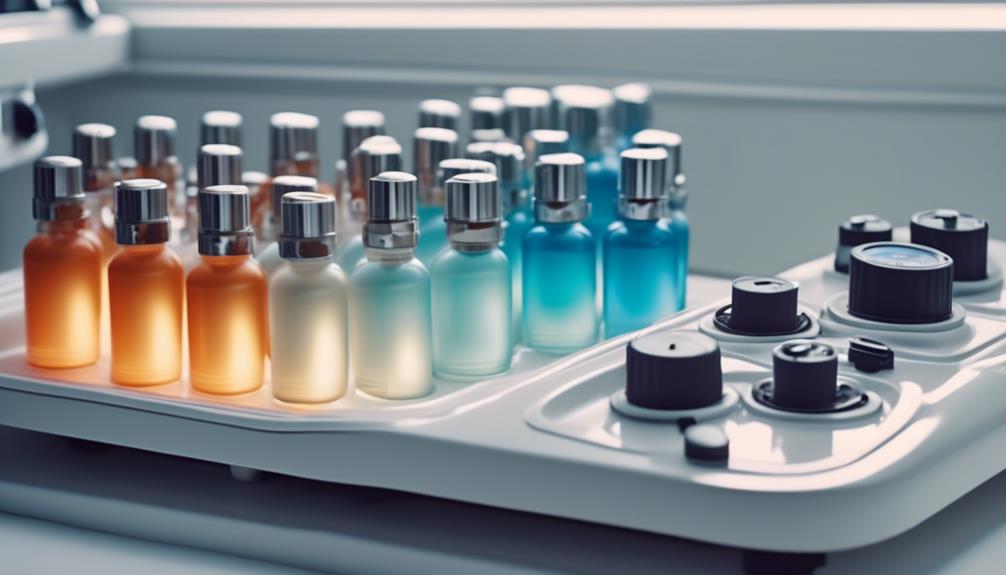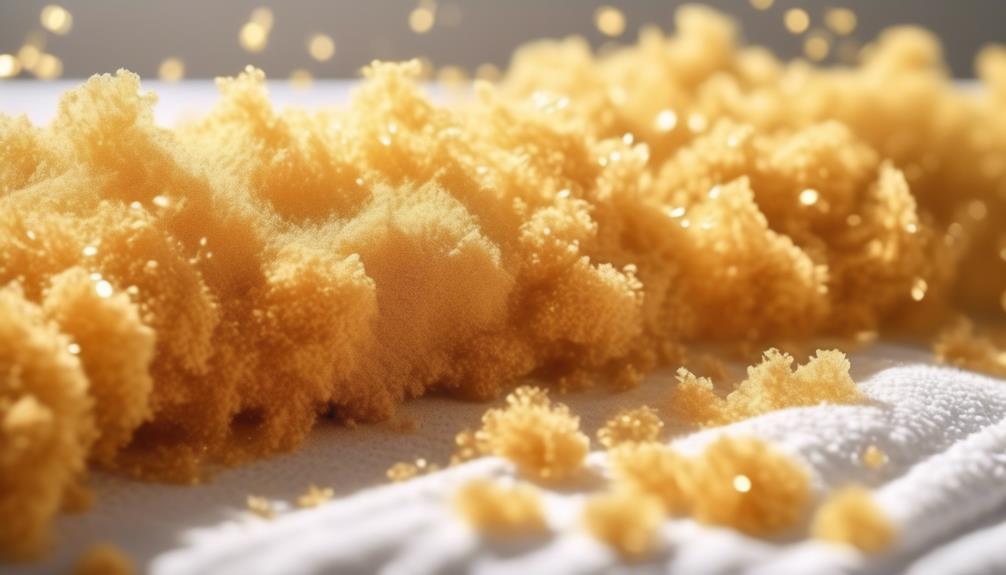Look, you’ve probably heard the buzz about how important it is to suss out whether you’re a porcelain princess or an olive queen, but let’s get real for a sec—you need the deets on your skin’s true vibe if you wanna bronze up without the burn.
Your skin type dictates how your bod reacts to the sun’s kiss, and trust me, you don’t wanna play it by ear when UV is involved. So, let’s break it down: from assessing your natural undertones to understanding your skin’s tanning potential, getting to know your skin is your ticket to that glow-up.
Stick with me, and I’ll show you how to tailor your tan to perfection—because when you play the tanning game smart, you’re in for the win. Let’s just say, what you discover might just be the golden ticket to your best tan ever.
Key Takeaways
- The Fitzpatrick Skin Types scale may not accurately determine skin type or cancer risk for People of Color.
- Understanding your skin’s reaction to sunlight is essential for a healthy glow.
- Different skin tones have varying degrees of burn and tanning ability.
- Evaluating your melanin levels helps determine your sensitivity to UV light and tailor your tanning experience.
Understanding Fitzpatrick Skin Types
Let’s understand the Fitzpatrick Skin Types—your guide to figuring out how your skin plays the tanning game. You’ve probably wondered why some folks turn into bronze deities while others rock the lobster look post-beach day, right? Well, it’s all about your skin type.
This scale’s got six types, I to VI, and it’s like a tanning compass for your bod. But here’s the tea: it wasn’t always inclusive. Initially, it left out darker skin tones, which wasn’t cool for our melanin-rich pals. It’s crucial to remember that the scale has its flaws, especially when non-POC professionals use it. Sometimes, it’s like trying to fit a square peg in a round hole, you know?
The lingo on the scale talks about how much you tan or burn, but let’s be real—it can get pretty subjective. And for People of Color, it mightn’t nail your skin type or cancer risk on the head. So, when you’re trying to figure out where you land on this spectrum, take it with a grain of salt. After all, it’s more about understanding your skin than slapping on a label.
Assessing Your Natural Skin Tone
You gotta check out your pigment levels ’cause that’s the real deal in figuring how you tan.
Then, put your skin to the test with some sunlight – does it say ‘hello, sunbeam’ or ‘ouch, that’s hot’?
Analyze how your tan game goes; do you bronze like a goddess or turn into a lobster?
Let’s find out!
Identify Pigment Levels
Understanding your skin’s natural pigment level is crucial before you hit the tanning salon—think of it as your personal UV blueprint. You wanna know what you’re working with, right? So, let’s break it down with a super simple table:
| Skin Type | Description |
|---|---|
| I | Always burns, never tans |
| II | Burns easily, tans minimally |
| III | Burns moderately, tans gradually |
| IV | Burns minimally, tans well |
| V | Rarely burns, tans profusely |
| VI | Never burns, deeply pigmented |
Spot your skin type, and you’ve got a heads-up on how your skin might throw shade (or not) when it comes to UV exposure. If you’re a Type 1, darling, sunscreen is your BFF. Type 3A? You can catch some rays, but don’t get too cozy. Remember, it’s all about loving and protecting that gorgeous skin of yours!
Sunlight Reaction Test
A Sunlight Reaction Test is your go-to move to figure out how those UV rays vibe with your unique skin tone.
It’s like swiping right on your natural fab features: the color of your bare skin, the hues of your hair and eyes, even those cute freckles.
And yep, it digs into your family tree to get the full scoop on your sensitivity to UV.
Analyzing Tan Responsiveness
In the tanning world, it’s essential to know your skin’s baseline – that natural hue you rock before basking in any bronzing glory. You’ve gotta assess your vibe under that big UV spotlight to slay the tan game safely. If you’re the type who always burns, slow and steady is your mantra.
Here’s a quick cheat sheet to get a handle on your tan responsiveness:
| Skin Tone | UV Reaction | Tanning Ability |
|---|---|---|
| Fair | Always burns | Rarely tans |
| Light | Burns easily | Tans with care |
| Medium | Burns moderately | Tans well |
| Olive | Rarely burns | Usually tans well |
| Dark | Minimal or no burning | Tans profusely |
Identifying Your Skin’s Sun Reaction
Before you hit up the tanning salon, let’s figure out how your skin plays with the sun’s rays. Knowing your skin’s sun reaction is like swiping right on the perfect match—it’s essential for a lasting, healthy glow. So, here’s the tea:
- Does your skin turn into a lobster look-alike after just a few minutes in the sun? That’s a classic sign of high skin sensitivity.
- Can you chill in the sun and slowly turn into a golden god/goddess, or does your skin play hard to get, barely changing color? It’s all about gauging that tan level.
- Ever dealt with a sunburn that morphs into a tan? That’s your skin’s plot twist, but remember, it’s a risky business that could lead to skin cancer.
Listen, you want to keep your skin looking and feeling flawless, right? Understanding your skin’s reaction to UV rays isn’t just about looking fab—it’s about protecting your health, too. Ignoring your skin’s whispers (or screams) of sensitivity could lead to not-so-chic consequences, like premature aging or, even worse, skin cancer.
Evaluating Melanin Levels
Let’s talk about your glow-up game plan at the tanning salon by checking out your melanin levels.
You’ve gotta know where you stand — more melanin means you’ll bronze up nicely and fend off those UV rays better.
If you’re on the lighter side, though, it’s super important to play it safe to avoid a total sunburn bummer.
Understanding Melanin’s Role
To get that golden glow without the burn, you’ve gotta understand how melanin works in your skin. This pigment is your personal bodyguard against the sun’s harsh vibes, determining your skin type and how you bronze up—or don’t.
Here’s the deal:
- Melanin Levels: More melanin equals a darker skin tone, which usually tans easier and burns less.
- Skin Type: Ranges from I to VI, with I being the fairest and VI being the deepest. Your spot on this spectrum is key for your tan plan.
- Sunburn Potential: Less melanin means you’re more likely to turn into a lobster than a sun-kissed deity.
Don’t just guess your skin type—evaluate your melanin to keep your skin game on point and protect your glow.
Assessing Personal Melanin Content
Digging into your skin’s natural color and features can unlock the secrets of your melanin levels, paving the way for a tailored tanning experience that’s all about you. Let’s get real about your skin type and melanin content.
Peek at your untouched skin tone, hair color, and those cute freckles. Do your eyes sparkle with hints about your tanning potential?
Your sunburn and bronze-ability are like your personal tanning fingerprint. Sure, the Fitzpatrick Skin Types might give you a clue, but don’t let it box you in, especially if you’re rockin’ a rich skin tone.
Tanning isn’t one-size-fits-all, and neither are you. So let’s get personal and find out just how your melanin plays in the tanning game.
Melanin Impact on Tanning
Understanding your melanin level is key to mastering the art of the tan, as it dictates just how much sun your skin can handle before it turns from glow to no-go. It’s the real deal in the skin tanning game. The melanin impact on tanning isn’t just some buzzword; it’s your personal sun-kissed blueprint.
- Darker skin with more melanin: You’re the tanning maven, less burn, more turn.
- Lighter skin with less melanin: Take it slow, babe, you’re more at a sunburn risk.
- Evaluating your melanin: It’s like unlocking the secret level in tanning prowess.
Determining Sensitivity to UV Light
Assessing your skin’s reaction to UV light is key to nailing that perfect tan without the burn. We’re talking about that glow-up that feels just as good as it looks, you know? So, let’s break it down.
Your skin type isn’t just about whether you’re fair or dark; it’s about how your skin vibes with UV light.
Now, trained sunbed operators? They’re like your personal tanning gurus. They’ll check out your skin’s baseline and guide you to a tan that’s goals, not ouch. Because here’s the scoop: sunburn potential isn’t a one-size-fits-all deal. It’s as unique as your latest selfie filter.
Enter the Fitzpatrick Skin Types (FSP) – this isn’t just some boring chart; it’s like a roadmap to your best bronze. Ranging from type I to VI, it’s all about how quickly you burn and how smoothly you tan. Whether you’re a type that turns lobster-red at the mere mention of sunlight or one that bronzes like a beach goddess, knowing your FSP is like unlocking the secret to your sun-kissed potential.
Selecting the Appropriate Bronzer
Once you’ve got a handle on your skin’s love-hate relationship with the sun, picking the right bronzer is your next power move for that enviable glow. Your bronzer shouldn’t just complement your skin type but also align with your tanning salon aspirations. So let’s get personal and find that perfect match to boost your radiance!
- If your skin is fair and tends to burn, look for a bronzer with SPF. It’s like a protective hug for your skin, preventing a sun-kissed look from turning into a sun-scream scenario.
- Dreaming of a tan without the commitment? A self-tanning bronzer is your BFF. It’ll give you a gradual, natural tan that has everyone fooled, minus the sun dates.
- Got skin that shines brighter than your future? An oil-free bronzer will keep the glow without the grease.
Preparing Skin for Tanning Beds
You’ve got to play it smart and safe, starting with a gradual increase in exposure time. No one’s chasing a sunburn here, right?
If your skin’s on the oily side, grab an oil-free, water-based cleanser to keep things fresh. Follow up with a light moisturizer that won’t clog your pores. You want your skin tanning experience to be slick, but not your face!
Dry skin folks, it’s all about hydration. Slather on a rich moisturizer to feed your thirsty skin. It’ll thank you by tanning beautifully.
Combination skin can be a bit tricky, but you’ve got this. Hit those shiny spots with an oil-absorbing product and pamper the dry patches with a creamy lotion.
And if you’re blessed with normal skin, keep it simple with a mild daily cleanser and a lightweight moisturizer at night.
Customizing Your Tanning Schedule
Crafting the perfect tanning schedule is key, tailoring exposure to keep your skin glowing and safe from burn. You’ve got to listen to what your skin is telling you, because, it speaks volumes about how you should tan. You wouldn’t wear the same outfit as everyone else, right? So why follow someone else’s tanning routine?
Here’s the lowdown for keeping it real with your skin type at the tanning salon:
- Gradually increase exposure time to avoid sunburn and to build that sun-kissed look safely.
- Pay attention to how sensitive your skin is to UV rays, so you can plan your tanning sessions without any ouch moments.
- Always chat with the pros—trained sunbed operators know their stuff when it comes to customizing your tanning schedule.
Whether you’re a tanning newbie or a bronzed veteran, adjusting your sessions to your unique skin type is essential for tanning salon success. So, let’s get personal with your tanning plan, and you’ll be rocking that radiant glow without any drama. Remember, it’s all about that slow and steady glow-up, tailored just for you.
Frequently Asked Questions
Which Skin Type Is More Prone to Tanning?
If you’re a 3B, 3C, or 4, you’ve hit the jackpot. You’ll tan like a pro, barely ever burn, and keep that golden glow with ease.
Skin types 5 and 6? You’re in the clear too, tanning’s a breeze for you. Keep it cozy, protect your skin, and don’t overdo it, because every tan comes with a tale.
Can Some Skin Types Not Tan?
Absolutely, some skin types just don’t tan, no matter how much you might want them to. If you’ve got skin type 1, you’re basically signing up for a sunburn rather than that golden glow.
It’s a bummer, but it’s crucial you’re aware so you don’t end up hurting your skin. Better to rock your natural complexion than risk damage, right?
Always listen to your skin—it’s got your back!
Can Type 1 Skin Ever Tan?
Like trying to ignite a damp matchstick, you’re facing an uphill battle trying to tan with Type 1 skin. It just doesn’t catch a glow. You’ve gotta embrace that porcelain vibe and slather on the sunscreen like it’s your bestie.
Forget those sun-kissed dreams – protecting your fair skin is key. The salon’s got your back with tips and top-notch SPFs to keep you safe while you rock your natural shade.
Can You Tan With Type 2 Skin?
You can totally catch some golden vibes, but it’s gonna be subtle.
If you’re a 2A, it’s a tricky game – you’ll burn quicker than a snap.
For the 2Bs and 2Cs, you’ll tan just a touch, but patience is key.
Don’t expect to be a bronze goddess overnight, though.
It’s all about baby steps and sunscreen, got it?
Stay safe and slay!




